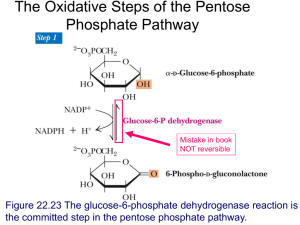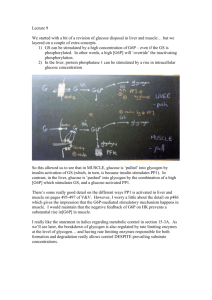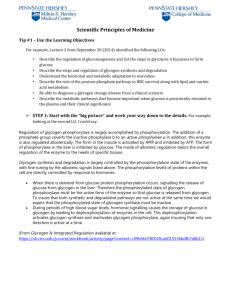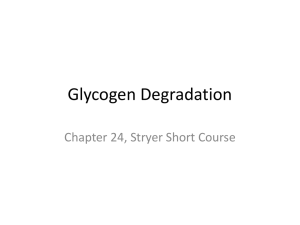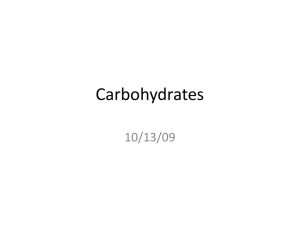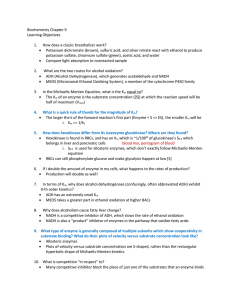Kevin Ahern's Biochemistry Course (BB 350) at Oregon State University
advertisement
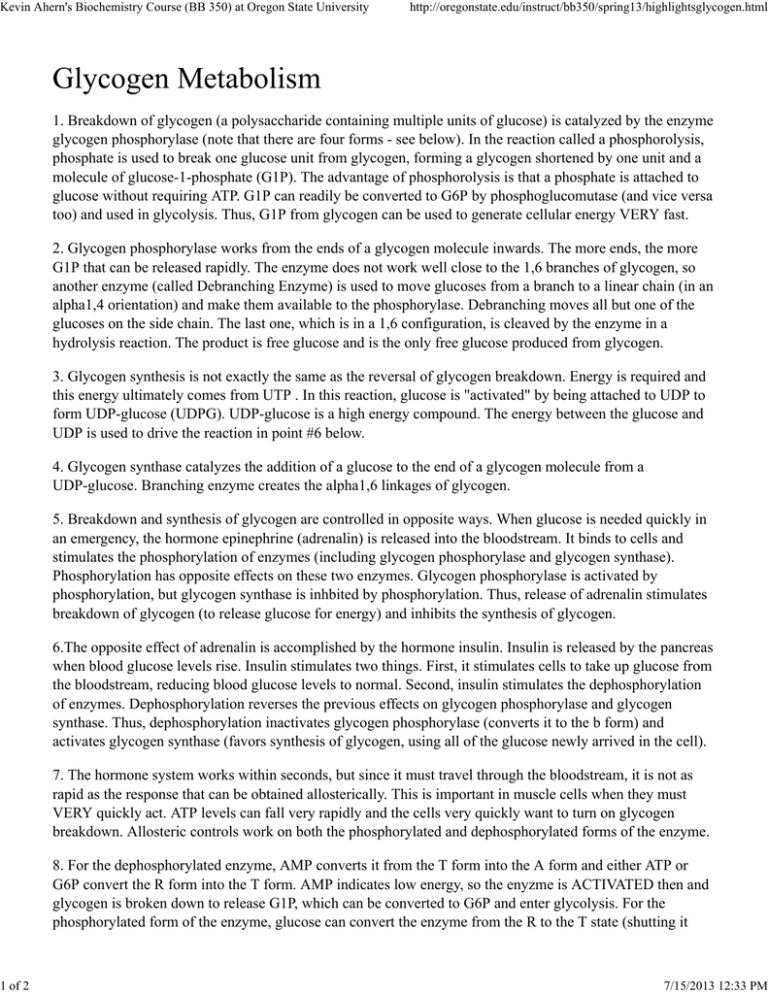
Kevin Ahern's Biochemistry Course (BB 350) at Oregon State University http://oregonstate.edu/instruct/bb350/spring13/highlightsglycogen.html Glycogen Metabolism 1. Breakdown of glycogen (a polysaccharide containing multiple units of glucose) is catalyzed by the enzyme glycogen phosphorylase (note that there are four forms - see below). In the reaction called a phosphorolysis, phosphate is used to break one glucose unit from glycogen, forming a glycogen shortened by one unit and a molecule of glucose-1-phosphate (G1P). The advantage of phosphorolysis is that a phosphate is attached to glucose without requiring ATP. G1P can readily be converted to G6P by phosphoglucomutase (and vice versa too) and used in glycolysis. Thus, G1P from glycogen can be used to generate cellular energy VERY fast. 2. Glycogen phosphorylase works from the ends of a glycogen molecule inwards. The more ends, the more G1P that can be released rapidly. The enzyme does not work well close to the 1,6 branches of glycogen, so another enzyme (called Debranching Enzyme) is used to move glucoses from a branch to a linear chain (in an alpha1,4 orientation) and make them available to the phosphorylase. Debranching moves all but one of the glucoses on the side chain. The last one, which is in a 1,6 configuration, is cleaved by the enzyme in a hydrolysis reaction. The product is free glucose and is the only free glucose produced from glycogen. 3. Glycogen synthesis is not exactly the same as the reversal of glycogen breakdown. Energy is required and this energy ultimately comes from UTP . In this reaction, glucose is "activated" by being attached to UDP to form UDP-glucose (UDPG). UDP-glucose is a high energy compound. The energy between the glucose and UDP is used to drive the reaction in point #6 below. 4. Glycogen synthase catalyzes the addition of a glucose to the end of a glycogen molecule from a UDP-glucose. Branching enzyme creates the alpha1,6 linkages of glycogen. 5. Breakdown and synthesis of glycogen are controlled in opposite ways. When glucose is needed quickly in an emergency, the hormone epinephrine (adrenalin) is released into the bloodstream. It binds to cells and stimulates the phosphorylation of enzymes (including glycogen phosphorylase and glycogen synthase). Phosphorylation has opposite effects on these two enzymes. Glycogen phosphorylase is activated by phosphorylation, but glycogen synthase is inhbited by phosphorylation. Thus, release of adrenalin stimulates breakdown of glycogen (to release glucose for energy) and inhibits the synthesis of glycogen. 6.The opposite effect of adrenalin is accomplished by the hormone insulin. Insulin is released by the pancreas when blood glucose levels rise. Insulin stimulates two things. First, it stimulates cells to take up glucose from the bloodstream, reducing blood glucose levels to normal. Second, insulin stimulates the dephosphorylation of enzymes. Dephosphorylation reverses the previous effects on glycogen phosphorylase and glycogen synthase. Thus, dephosphorylation inactivates glycogen phosphorylase (converts it to the b form) and activates glycogen synthase (favors synthesis of glycogen, using all of the glucose newly arrived in the cell). 7. The hormone system works within seconds, but since it must travel through the bloodstream, it is not as rapid as the response that can be obtained allosterically. This is important in muscle cells when they must VERY quickly act. ATP levels can fall very rapidly and the cells very quickly want to turn on glycogen breakdown. Allosteric controls work on both the phosphorylated and dephosphorylated forms of the enzyme. 8. For the dephosphorylated enzyme, AMP converts it from the T form into the A form and either ATP or G6P convert the R form into the T form. AMP indicates low energy, so the enyzme is ACTIVATED then and glycogen is broken down to release G1P, which can be converted to G6P and enter glycolysis. For the phosphorylated form of the enzyme, glucose can convert the enzyme from the R to the T state (shutting it 1 of 2 7/15/2013 12:33 PM Kevin Ahern's Biochemistry Course (BB 350) at Oregon State University http://oregonstate.edu/instruct/bb350/spring13/highlightsglycogen.html down), but if glucose is not present, the enzyme will flip automatically into the R state. This is why we consider the phosphorylated form of the enzyme more active - it is much more easily activated to the R state. 2 of 2 7/15/2013 12:33 PM
